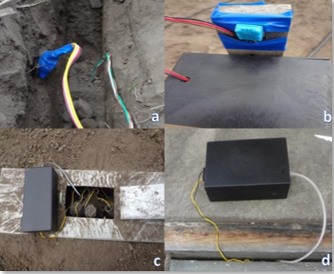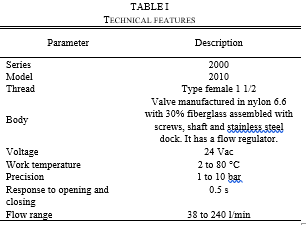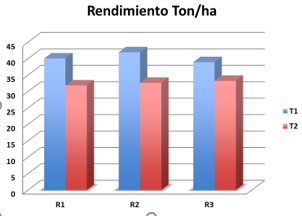Introduction
The applications of the Wireless Sensor Networks (WSN) has grown worldwide, play an important role to increase the ubiquity of the networks with low cost and easy implementation smart devices, using standards such as IEEE 801.15.4 in the physical layer and 6LoWPAN in the network layer 1.
The same ones that are not compatible with the TCP/IP protocol stack. For this reason, the IETF (Internet Engineering Task Force) developed a 6LoWPAN (IPv6 over Low-Power Wireless Personal Area Networks) communication standard which improves its functionality 2.
A WSN is a network formed by a series of small low-cost, low-energy, and easily-deployable sensors. Providing scalability, flexibility, and cost reduction, it is a viable solution for precision agriculture applications. WSN technologies are used in agriculture to provide remote monitoring of parameters such as temperature, relative humidity, luminosity, among others, in order to create a simple and effective interaction environment to monitor the growing of crops 3.
One of the most outstanding applications of these networks is AP, agriculture of precision, which emerged from the 80`s and is a method that proposes the use of modern technologies and communication tools that are capable of facilitating the continuous collection of physical variables involved in the development of production for subsequent analysis and immediate decision making 4.
Ecuador is a country with a deep agricultural vocation, which prioritizes the production of crops such as potatoes, considered the basis of human nutrition, especially in the Ecuadorian sierra 5.
Potato is a demanding crop of water and very sensitive to water deficit, which is why an important good water supply during all stages of its phenological growth stage, otherwise it may cause disorders in the tuber.
The potato plant is sensitive to water stress and water availability in the soil cannot be less than 30% to achieve optimum yields. In the potato crop, a high availability of assimilates promotes the growth of roots, stolons, leaves, and branches 6.
The effect of water stress is the reduction of foliage growth for the partition of assimilates to the tubers, which determines a decrease of the crop cycle. The highest water demand occurs in the plant growth and germination stages of the tubers, which is where the optimum crop development is assured, the other plant development stages will require the water resource but in a smaller proportion 6.
The water resource is both limited and vital agricultural input in agriculture, its optimal distribution is a priority. Currently, different irrigation methods are installed lacking a system that together allows to measure soil moisture, control irrigation time, and to identify the portion of soil that really needs to be irrigated. This is a disadvantage due to the irrigation deficit causes a low yield in its production and, on the other hand, the excess of irrigation can trigger permanent soil infertility 7.
The aim of this study was to optimize the irrigation water in the potato (Solanum tuberosum L. cv. INIAP Natividad) crop to ensure maximum crop productivity by exposing an exploration of the relevance and real benefits of the automation of drip irrigation using WSN and 6LoWPAN wireless network sensors in Riobamba-Ecuador.
Study area
The study was conducted at the Irrigation Experimental Center, Macaji campus of the Escuela Superior Politécnica de Chimborazo-ESPOCH, Riobamba, Ecuador located at an altitude of 2821 meters above sea level, a Latitude of 1° 39'18.82''S, Longitude 78°40'39.99" with an average temperature of 13.5°C, an annual rainfall of 350 mm and a relative humidity of 66.4%. For the investigation in the field, 6 parcels of 10×10 meters each other were installed in a total area of 600 m2 of net area for the assay with a separation of 2 meters among them, in each plot were located ten rows of 0.8 m of length and 0.2 m of width, were located in each plot. The drip irrigation system was implemented using a line of 0.25 m drippers and a flow rate of 1.02 liters per hour.
Network design
A WSN is a network of short range, low speed, and low energy consumption that consists of a set of spatially distributed autonomous nodes that monitor their environment7.
The designed network consists of six nodes, three of them are sensor nodes, two are actuating nodes and the main one, is the network gateway. All of them were installed with a star topology in which each sensor/actuator node (final device) maintains only a direct communication path with the gateway. This simple topology is justified by the small number of devices that make it up.
In addition, a WSN network with 6LoWPAN was installed, which have allowed the monitoring of some parameters (soil moisture, maximum, and minimum temperatures, relative humidity) for the soil moisture content determination in real time and therefore, programming the irrigation efficiently according to the needs of the potato crop. Additionally, a portable meteorological station was installed to collect sufficient and important agroclimatic information.
The WSN are widely used in the monitoring and control of rainfall in agricultural areas of Colombia 8. The WSN were constituted by sensors capable of taking information from the environment with which they interact and then be processed and sent through wireless links to the network gateway to send them later to the base station, where information is stored and controlled for the decision making.
Currently, the most used networks are those that are based on the specifications of the standard IEEE 802.15.4. Given these concerns, 6LoWPAN arises due to the facility it offers to interconnect IPv6-based systems with TCP/IP architectures9.
Finally, through the Contiki operating system, an IP communication system is incorporated for both IPv4 and IPv6, which makes easier and safer the information storage 10.
Experimental Procedure
In this research, a complete block design was carried out with two treatments and three replicates, with automated irrigation (T1) and manual irrigation (T2). The procedure of planting the potato plants was as follows: location of the seed at 5 cm of soil depth and a distance among rows of 0.80 m and 0.25 m among plants.
To determine the agroclimatic information and be able to establish the water requirements for potato crop, sensors were installed linked to a portable weather station, which bring the information of maximum-minimum temperatures, relative humidity, and wind speed, among others. Additionally, installed sensors provide relative humidity readings ranged from 20-95 (%) and temperature 0-50°C in the soil.
The cultivar of potato used is INIAP Natividad, with a cultivation cycle of 153 sowing-harvest days. The parameter evaluated was the harvest, yield per plot, yield classification, weight, number of tubers, water footprint determination, and cost benefit analysis. The agronomic management of the potato crop was applied according to the agroclimatic conditions of the study area.
Hardware design
The technical operation and configuration features of the main components that constitute the sensor nodes and Gateway node of the proposed network were considered, as the picture shows Fig.1.
Determination of the irrigation system
To determine the potato crop evapotranspiration, the standard type A evaporimeter tank was used, the formulas used to determine the daily water requirements were as follows:
where εt o is the evapotranspiration of reference (mm/day), evais evaporation (mm/day), k p is the FAO correction factor (RH%,Vvm/s, Barlovento), εt c is the evapotranspiration of potato crop (mm/day), and k c is the crop development, nutritional requirement and irrigation.
For the first crop irrigation, the soil moisture content was determined by the gravimetric method. Thus, it was completed to field capacity, with this information, the humidity sensors were calibrated for the automation, as shown in Fig. 2(a) and Fig. 2(b).
Drip irrigation system
The irrigation system implemented consists of: irrigation belts located 1 m apart among rows with drippers every 0.25 m of separation, with a flow rate of 1.02 l/h per dropper, two electro-valves depending on their respective relay, which receives the on-off commands from the sensor nodes 1 and 2 from the system, see Fig. 2(c).
The solenoid valves receive the start command when the consumption of useful water in the soil is 25%. They receive the shutdown command when the humidity sensor determines that they reach field capacity.
Sensor nodes
All the nodes in the network include at least one processing module, a communication module, a power supply module, and interfaces for their connection. The sensor nodes have been placed on a wooden base 1 m deep to avoid direct contact with soil moisture. The location of the nodes and their sensors was as follows:
Node 1 is located at 1/3 of potato crop area with the aim to acquire information from the edges of the plot.
Nodes 2-3 are located in the plot center.
Soil moisture sensors are located at 15 and 45 cm of soil depth, where the greatest amount of the mass of the absorbent root is found in the potato crop.
Central node or Gateway
Once the modules of each node are configured, the gateway forms the network, randomly assigning a unique address to identify it. The central node has been installed 30 m from the portable weather station, as shown in Fig. 2(d).
Information processing and storage module
The web server that stores the graphical interface and database is installed in one of the offices closest to the potato crop, where the internet is available for the app access.
Response module
Two electro-valves were installed inside metal boxes closed to the lateral irrigation pipe. They are through their relays execute the orders sent by the sensor nodes 1 and 2 to which they are connected. When the values obtained from the soil moisture content are outside the minimum (7%) and maximum (15%) ranges established after the sensor calibration, they open or close respectively one of the electro-valves (Table I).
Functionality tests
The tests are established according to the scope of compliance with the objectives, focusing on verifying that it is possible to have a technological tool, which have allowed to control a drip irrigation system that works according to the potato crop parameters (relative humidity, temperature, soil moisture) and ensure the maximum crop productivity monitored in real time by the WSN network with 6LoWPAN.
Statistical analysis
In this study, ANOVA for the complete block design was carried out with 2 treatments and 3 replicates with Tukey at 5% for treatments. The analysis of the variance determined that there is no significance among replicates. To identify significant difference among treatments and statistical significance for all comparisons was made at p < 0.05 Tukey’s multiple ranks tests were used to compare the mean values of treatments.
Simulation Results
In the Tukey test at 5% among replicates, no significant difference was found in the analysis of variance with the same test for T1 and T2, it is determined to be highly significant, with T1 = automated irrigation with an average of 40.27 tons per hectare and the treatment T2 manual irrigation with an average of 32.53 tons per hectare (Figure 3).
Water footprint
In terms of water consumption compared to the performance of each treatment, we have: for T1 (automated irrigation) we used 51.15 l/kg of potato crop production and for T2 (manual irrigation) 52.38 l/kg of potato crop production. These evidences a clear saving of the hydric resource and an optimum crop development. With reference to the crop phase determination day-sowing-harvest, the initial phase had achieved duration of 38 days, the development phase 33 days, the intermediate phase 12 days, and the final phase 70 days, respectively, defining days sowing harvest to 153. In the corresponding tuber yield categorization of T1 were as follows:
Of first: 66%
Of second: 24%
Of third: 10%
In the case of T2 were as follows:
Of first: 26%
Of second: 35%
Of third: 39%
In treatment T1 (automated irrigation) compared to T2, it is possible to determine that with the saving of 20% of water resource, a potato crop yield of 19.2%.
Motivation
Recent practices in precision agriculture include two main micro irrigation methods, which promote interesting water efficiency. The first method is the drip irrigation. This irrigation system is composed of the following components: water source (generally is a tank), which is connected with a main tube called main pipeline. To this line, several pipes are connected using manual or electrical valves that control the water flow. The pipes go through the field and distribute water for each plant.
The second method is the sprinkler irrigation, which delivers water through a pressurized pipe network to the nozzles of sprinkler, which spray the water into the air 11. However, this method is less efficient than the drip one, since more water is losing due to evaporation and runoff.
Therefore, in this study we choose the drip strategy for our design. We note also that our proposed model is designed for a site-specific irrigation where the crops are characterized by a spatial temporal variation of the irrigation requirements. The variability comes from the soil type, crop type, crop, and meteorological conditions. The modular configuration of the automated irrigation system allows it to be scaled up for larger greenhouses or open fields. The automated irrigation system implemented was found to be feasible and cost effective for optimizing water resources for potato crop production. Besides the monetary savings in water use, the importance of the preservation of this natural resource justify the use of this type of irrigation systems.
Mostly, water management depends on types of soil such as alluvial sandy soil with different layers of sand and silt. If clay content having less than 5% and water retention capacity is less than 50 mm3/mm3, then it has to irrigate every 7 days. If well-drained red soil of high physical potential, but with low pH and clay is equal to 15-20%, then it has to irrigate every 20 days. The quality of potato crop depends on the type of water supply; water supply can be from different resources such as gravitational water, free drainage, rainfall, and available water, estimating soil moisture and relationship with crop yield using surface temperature and vegetation index12.
Wireless sensor network (WSN) have many applications such as industrial automation, automated and smart homes video surveillance, traffic monitoring, medical device monitoring, monitoring of weather conditions, air traffic control, robot control, personal body area network 12.
Another similar study is carried out by 13, who through WSN-Wireless Sensor Networks, presents a solution for the monitoring of environmental quality in the city of Quito-Ecuador, which, beyond monitoring the air quality, extends to the most conflictive sectors of the city of Quito-Ecuador.
In 14, applied an Internet Protocol version 6 (IPv6) in a wireless sensor network (WSN), for the remote monitoring of short-cycle crops at the La Pradera farm, this research presents a process similar to the one applied but does not show the contribution Significant use of wireless networks in potato crop productivity.
The present research on the contrary potentiates the use of WSN with 6LoWPAN for the monitoring and control in real time of the productive process of the cultivation of the potato and makes possible the taking of opportune decisions to assure an optimal development of the same.
Use of Information technology introduced a new concept in agriculture as Precision Agriculture. The precision framing adoption is a cyclic process of data gathering, diagnostic, data examination, accuracy field operation and evaluation. For state and condition monitoring of crop there is visual inspection, color estimation and mold localization. For monitoring the conditions wireless sensor network is preferred since it provides results in real time and there is no limitations of distance and physical barrier, as data provided is in real time15.
The irrigation system efficiency reflects the interaction between irrigation and crop yield. The major problem of agriculture is the scarcity and quality of water resources. For the quality water it has no direct effect on water use efficiency, but irrigation system has great effect on water use efficiency 16.
The results of this study showed that farmers, when implementing the system, will achieve a significant saving of the time it takes them to collect potato crop data, which allows them to have greater control of the variables involved in the process. The contributions that these automated control systems can give the user are multiple and increasingly necessary to reduce task time, optimize resources and respond immediately, solving problems with greater efficiency.
Conclusion
The interoperability of WSN networks with TCP/IP architectures has been demonstrated by presenting the data collected by the WSN in the designed web application. The irrigation system can be adjusted to potato crop response and in addition, a variety of specific crop needs, which requires minimum maintenance. With the implementation of the system, an intelligent irrigation has been obtained that provides the potato plant with the amount of water necessary and sufficient for its development, thus avoiding unnecessary waste of scarce water resources. The research responds to the need of the farmer, to have a technological tool that allows him to acquire information on agroclimatic parameters that were previously carried out manually. The implementation of the WSN with 6LoWPAN has allowed automating the irrigation of a potato crop, thus achieving a technology tool that allows quick access to data to help decision making. The studied cultivar Natividad INIAP of potato crop was attended to in its water requirements, and a good branching, yield, size and crop development, which was observed under the assay conditions.



















